Is The End Nigh?
Head of Macro and Dynamic Allocation, Cross Asset Solutions
The first half of 2022 ended on a truly sour note for financial markets, with central banks aggressively tightening while economies are weakening. In the past, any sign of a marked slowdown in the developed world would be met and resolved by the (in)famous Greenspan “put”, a quick and convenient fix to calm the markets and revive the economy via lower rates or quantitative easing, or a combination of both. This time around is very different, as runaway inflation has basically tied the hands of policy makers, now desperately trying to catch up with the inflationary beast they have unleashed by keeping rates too low and for too long. This in turn has spooked the markets, leading to a broad based sell-off in equities and bonds with nowhere to hide besides inflation hedges such as commodities or breakevens. In June, however, the recessionary theme has made a comeback, as witnessed by some distinct rotations across and within asset classes. Although markets are now starting to price in a cooling of inflation and central bank hawkishness, we have yet to reach the lows in equity markets where we would be comfortable to reengage risk

So Near and Yet So Far

What’s Next
An orderly but massive derisking…
For the first time since March 2020, the three key asset classes – global equities, global bonds and global commodities – delivered negative monthly returns over the same period. In June, The MSCI AC lost -7.8%, the Barclays Global Aggregate -1.9%, and the Bloomberg Commodities index -7.2%. This is a rare event that has occurred only 26 times since 1990, or less than 10% of the time. As global equities usually respond favourably to a positive growth premium, commodities to a rising inflation premium, and sovereign bonds to higher recession risk, their respective June performances challenges the macro narrative that had justified the market’s repricing thus far.
In our view, tighter financial conditions with major surprise hikes from key central banks, such as the Fed’s 75bps or the SNB’s 50bps (even before the ECB), have been instrumental in this massive investor deleveraging. Moreover, while the market’s focus was mainly on interest rate changes, June also marks the first month of QT implemented by the Fed. As a result, lower liquidity in the system has had two consequences: 1) an end to the music for the most leveraged strategies or assets, such as the crypto complex, where Bitcoin declined 40% in a month, or the SPAC Index that tumbled -9.6%; 2) a challenge to the stability of asset correlations, which in turn has impacted the benefit of diversification. For example, the S&P Risk Parity 10% index lost -6.6% in June, its worst monthly return since March 2020 and sixth worst performance ever. As illustrated in the figure 1, the second quarter 2022 has been one of the worst in terms of sigma moves for liquid assets classes (19 assets including major equities, bonds, credit and commodities indexes + key currencies vs USD).
Figure 1: Number of one-sigma move across main assets
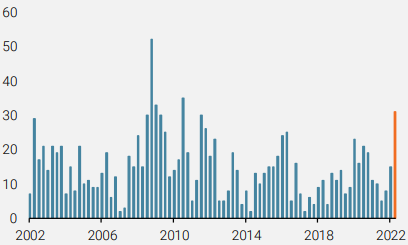
Source: Bloomberg, Unigestion, as of 30 June 2022 (19 instruments including main global equity, global bonds, credit indexes, commodities and major currencies)
In our view, the lack of dispersion within and across assets over the month compared to the year’s previous months confirms the deleveraging thesis, and that in such a context, reducing exposures is the best way to limit the drawdowns.
… leading to muted reaction in volatility
Last but not least, the VIX and VVIX did not react despite the market turmoil. The VIX rose only slightly by 3.2 points to 29.4, after having gained 12.8 points in April, when global equities tumbled by -8%, similar to the loss recorded in June. Earlier defensive positioning from systematic and flexible strategies and the lack of demand for hedges due to their high costs are the main reasons behind this unusual reaction of the volatility complex. In our view, at these levels, volatility markets are discounting a lot of downside and offer poor sensitivity and leverage to market weakness.
Figure 2: S&P500 vs VIX future index (inverted)
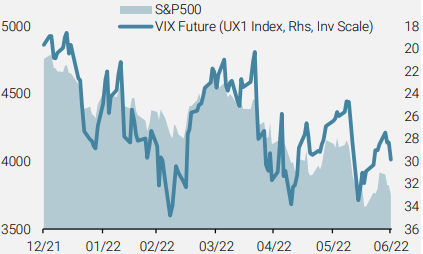
Sources: Bloomberg, Unigestion. Data as at 30.06.2022.
The prerequisite elements for a bottom in equities
Over the first 6 months of the year risky assets corrected sharply, incorporating higher interest rates as reflected in the larger inflation premium. Nevertheless, we observed divergence within the repricing of growth oriented assets between high yield credits and equities. The combination of lower liquidity, a reversal in central bank balance sheet expansion, and higher nominal rates have caused high yield spreads to widen, and although they are still well below their COVID peak, they have reached the levels last seen during the late 2018 slowdown (Figure 8).
Figure 3: US HY spreads vs. S&P500 PE estimates (percentile)
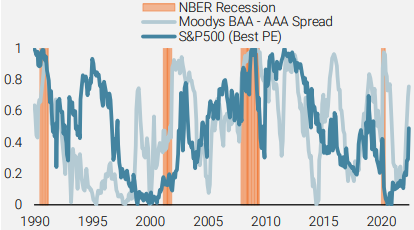
Sources: Bloomberg, Unigestion. Data as at 30.06.2022.
More importantly and unlike equities, where recent outflows have barely dented the strong post pandemic inflows, about 75% of the post COVID flows into HY have reversed. Historically, credit spread markets lead the equity markets when it comes to recession pricing. Consequently, we will wait for the following things to happen before calling a bottom in equities and reengaging risk in our diversified portfolios:
- Lower inflation expectations: Central banks will not reverse their hawkish stance until they get inflation back under control. This means that we will need to see monthly increases shift from a 0.5% to 0.7% range to 0.2% to 0.3%.
- Correction in earnings expectations: current expectations for 2022 earnings growth are positive and still too high. History shows that a recession entails a 15% decline in earnings.
- Outflows and a VIX capitulation spike: contrary to the fixed income space, which has seen large outflows this year, equity flows have slowed but are still positive on a year-to-date basis. We expect outflows following the Q2 earning seasons and a spike in VIX to 40 that could mark the capitulation and the last phase of the bear market.
- We believe that a peak in monetary policy normalisation will equate to a flat US 2-10Y curve and nominal rates at 3.5%, combined with negative earnings growth for 2022 that would push the SP500 to 3400/3500, 15% lower than current levels and 35% below the all-time high. This should result in a VIX above 35, which in turn would signify a better risk/reward for equities and bonds, as most of the recession risk and the inflation shock would be priced in at that point.
Unigestion Nowcasting
World Growth Nowcaster
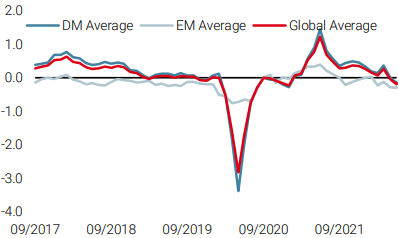
World Inflation Nowcaster
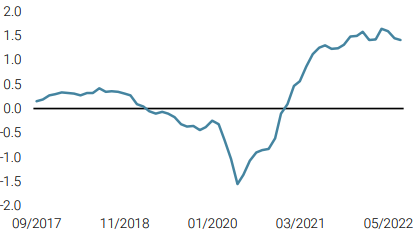
Market Stress Nowcaster
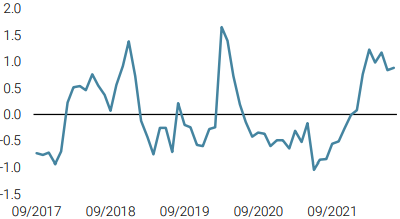
Weekly Change
- Last week, our World Growth Nowcaster ticked slightly lower as growth in US and Europe slowed further, while Chinese data improved.
- Our World Inflation Nowcaster moved down slightly with some easing in inflationary pressures in the US and Eurozone.
- Our Market Stress Nowcaster moved higher last week, as liquidity deteriorated further.
Sources: Unigestion, Bloomberg, as of 04 July 2022.
Important Information
This document is provided to you on a confidential basis and must not be distributed, published, reproduced or disclosed, in whole or part, to any other person.
The information and data presented in this document may discuss general market activity or industry trends but is not intended to be relied upon as a forecast, research or investment advice. It is not a financial promotion and represents no offer, solicitation or recommendation of any kind, to invest in the strategies or in the investment vehicles it refers to. Some of the investment strategies described or alluded to herein may be construed as high risk and not readily realisable investments, which may experience substantial and sudden losses including total loss of investment.
The investment views, economic and market opinions or analysis expressed in this document present Unigestion’s judgement as at the date of publication without regard to the date on which you may access the information. There is no guarantee that these views and opinions expressed will be correct nor do they purport to be a complete description of the securities, markets and developments referred to in it. All information provided here is subject to change without notice. To the extent that this report contains statements about the future, such statements are forward-looking and subject to a number of risks and uncertainties, including, but not limited to, the impact of competitive products, market acceptance risks and other risks.
Data and graphical information herein are for information only and may have been derived from third party sources. Although we believe that the information obtained from public and third party sources to be reliable, we have not independently verified it and we therefore cannot guarantee its accuracy or completeness. As a result, no representation or warranty, expressed or implied, is or will be made by Unigestion in this respect and no responsibility or liability is or will be accepted. Unless otherwise stated, source is Unigestion. Past performance is not a guide to future performance. All investments contain risks, including total loss for the investor.
Unigestion SA is authorised and regulated by the Swiss Financial Market Supervisory Authority (FINMA). Unigestion (UK) Ltd. is authorised and regulated by the UK Financial Conduct Authority (FCA) and is registered with the Securities and Exchange Commission (SEC). Unigestion Asset Management (France) S.A. is authorised and regulated by the French “Autorité des Marchés Financiers” (AMF). Unigestion Asset Management (Canada) Inc., with offices in Toronto and Montreal, is registered as a portfolio manager and/or exempt market dealer in nine provinces across Canada and also as an investment fund manager in Ontario and Quebec. Its principal regulator is the Ontario Securities Commission (OSC). Unigestion Asset Management (Copenhagen) is co-regulated by the “Autorité des Marchés Financiers” (AMF) and the “Danish Financial Supervisory Authority” (DFSA). Unigestion Asset Management (Düsseldorf) SA is co-regulated by the “Autorité des Marchés Financiers” (AMF) and the “Bundesanstalt für Finanzdienstleistungsaufsicht” (BAFIN).
